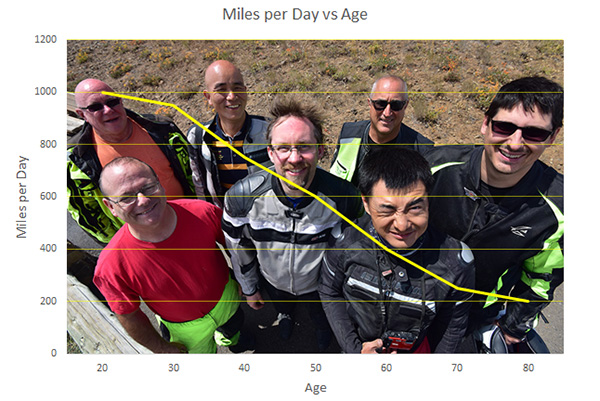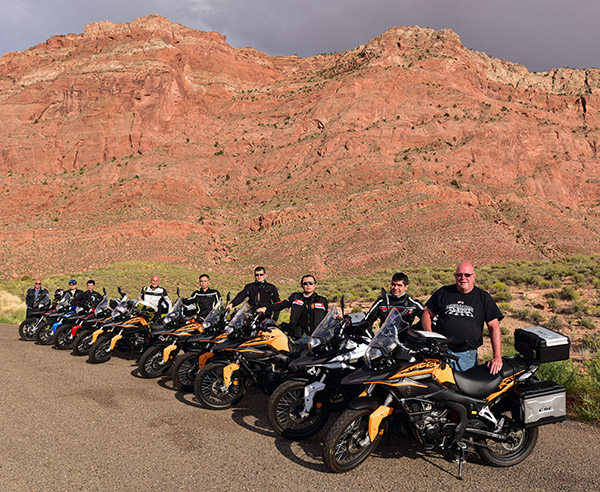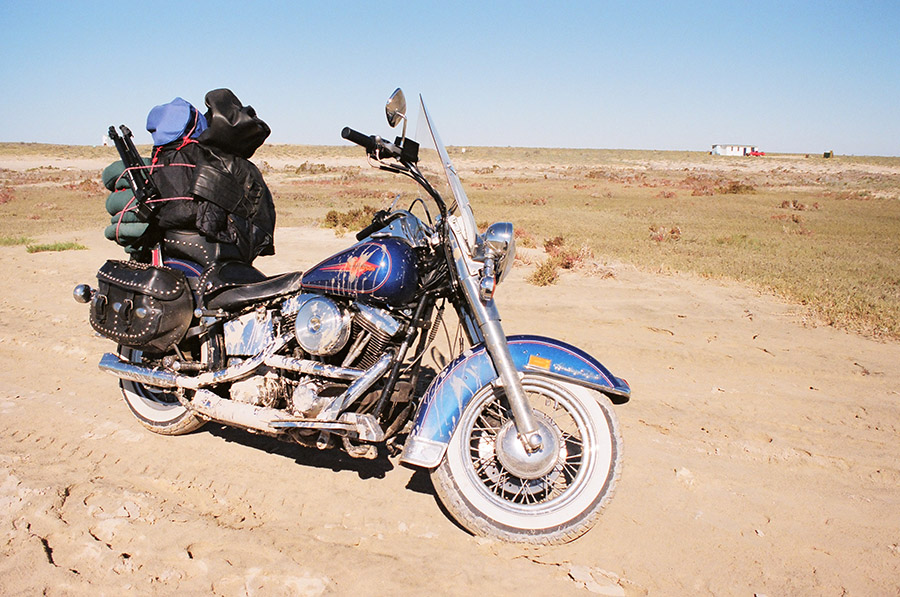How many miles can you ride in a day?
About 30 years ago I cranked 1070 miles in one day on a Harley Softail coming home from Mexico (and that was on an older Softail without the rubber mounted engine…it’s the one you see in the photo above). I was younger and I could ride, as they say, like the wind. A couple of weeks ago, I did a 250-mile day ride on my Enfield and it about wiped me out.
Gresh and I were talking about this recently, and I thought I would share my thoughts on how many miles you can plan on covering in a day. Maybe it will influence your planning. Maybe not. We get paid the same either way.
1: Age
Like I said above, big miles used to be no big deal for me. That’s not the case any more. After substantial scientific study and close observation of my geezer buddies over many decades, I developed a graph showing the relationship between age and how many miles you can reasonably ride in a day.

Like it or not, when we get older, it gets harder to rack up big miles. Serious scientific study went into the above, so if you want to debate our conclusions, bring facts. We want to hear them.
2: Weather
Weather plays a big role in how many miles you can ride in a single day, and here at ExNotes we rely heavily on our weather rock before leaving on any ride. You’ve probably heard about weather rocks. We sell weather rocks here on ExNotes and they are conveniently sized to fit into a tank bag. They work like this…you hang the rock from any available support (you have to supply your own string and support). Here’s how to interpret your weather rock:
-
- If the rock is wet, it means it’s raining and you should reduce however many miles you had planned to ride by half.
- If the rock is swinging, it means it’s windy that day, and you should reduce your miles by maybe a third.
- If the rock is hot to the touch, it means the temperature is elevated, and you should reduce your miles by maybe a third. Maybe even more.
- If the rock is cold, it means it’s cold, and you probably can ride as long as you dress appropriately. If the rock is really, really cold, though, maybe you should stay home. If there’s ice on the rock, you definitely should stay home.
ExNotes offers weather rocks in brand-specific models:
-
- If you ride a Harley, we offer chrome weather rocks for $395, chrome with conchos and black leather fringe weather rocks for $495, and chrome, conchos, fringe, and matching do rag weather rocks for $595 (freight and setup fees not included).
- If you ride a BMW, we offer the GS weather rock with an electronically adjustable center of gravity, BMW logos, and a one-year Starbucks gift certificate for $1995.
- If you ride a Ducati, you probably don’t need a weather rock (Ducati riders generally only ride their motorcycles short distances on clear days, anyway, although if you insist, we can provide a red rock for you personally autographed by the former famous racer of your choice, or we can put several rocks in a bag you can shake to sound like a Ducati clutch). Ducati rocks are free, or at least that’s what we tell you (we’ll recover the cost on your first valve adjustment and let you think you got the rock for free).
- If you ride a Chinese motorcycle, we sell an ExNotes weather rock decal for $2 and you can put it on your own rock.
3: Roads
The kind of roads you plan to ride make a huge difference. If it’s all freeway, you’ll be bored but you can rack up huge miles. If it’s surface streets (and a lot of us do everything we can to stay off the freeway), you won’t cover as many miles unless you’re riding in Baja, where you can run 140mph+ on the long straights south of Valle de Los Cirios. If it’s in the mountains, it will be less, unless you’re posting about your skills on Facebook, where the folks who post are world class riders (to hear them tell it). The same holds true for riding in the dirt. You just won’t cover as many miles.

4: Headcount
This is the big one, folks. Maybe I should have listed it first. If I’m riding by myself or with one of my motorcycle buddies in Baja, I can easily do over 500 miles a day. Throw in more people, and…well, read on, my friends.
The number of riders in your group has a profound impact on how many miles you can ride in a day. In the math world, we would say that the miles per day are inversely proportional to the number of riders in your group.

As a starting point (and after extensive research and mathematical modeling), the technical staff here at ExNotes developed Formula A:
A) Miles per Day = (M)/(N)
where:
M = Miles you want to ride
N = Number of riders in your group
What the above means is that as the number of riders in your group increases, the number of miles you can cover in a day decreases. That’s because with more riders you’ll start later in the morning, you’ll be stopping more often, and you’ll take more time at each stop. That is, unless you’re riding with me. Then Formula A reduces to Formula B:
B) Miles per Day = M
where:
M = Miles you want to ride
The B in Formula B stands for Berk because basically I’ll leave you behind if you’re not ready when I am. You can catch up with me later. You might think I’m joking. I’m not.
Formula A varies a little depending on what kind of riders you have in your group, and especially if you have a Rupert. Rupert is the guy who takes 20 minutes putting his motorcycle gear back on after every stop. I once rode with a Rupert who could take 20 minutes just putting his gloves on. He got better when we threatened to cut a few of his fingers off.
5: Your Motorcycle
There are several motorcycle factors that play a huge role in how many miles you can ride in a day. In the old days, a motorcycle was a motorcycle and we did it all with a single bike (touring, off-road, canyon carving, adventure riding, etc.). Today, you gotta get specific:
-
- ADV-style bikes are actually pretty comfortable and the ergonomics make sense. 500-mile days are easy. My KLR 650 was one of the best touring bikes I ever owned. It had phenomenal ergos.
- Standard motorcycles are also relatively comfortable and you can probably do 500 miles in a day, but you’ll feel it, especially if your bike does not have a windshield. My Enfield 650 Interceptor is a good bike, but it’s the one that wiped me out on that recent 250-mile ride.
- Cruisers look cool in motorcycle ads and they complement do rags and tattoos nicely, but they are less comfortable on long rides. I’ve found I can reasonably do 350-mile days on a cruiser without needing to see a chiropractor. Go much beyond that and you’ll feel it.
- Sportbikes generally cut into big miles, but a lot depends on your age. Good buddy Marty and I rode sportbikes on the 2005 Three Flags Classic (I was on a Triumph Daytona) and we did big mile days on that ride. But I was 20 years younger then and I bent a lot easier. I wouldn’t want to do it again.
- Classic bikes generally require shorter daily riding distances, particularly if they are British and equipped with electricals manufactured by Lucas (as in Lucas, the Prince of Darkness). I think a mid-’60s Triumph Bonneville is the most beautiful motorcycle ever created, but I wouldn’t want to ride Baja on one.
Beyond the style issues outlined above, there are other motorcycle factors to consider:
-
- Bigger motors generally mean more miles in a day, but bigger motorcycles can slow you down if they suck up too much fuel. One year at the International Motorcycle Show, Yamaha’s bikes all had labels that showed, among other things, fuel economy. The VMax, as noted by Yamaha, averaged 27 miles per gallon. You’d be making a lot more fuel stops on that one. 27 miles per gallon. I can’t make up stuff this good.
- Daily mileage is independent of displacement at 400cc and above (as long as fuel economy is not VMax nutty). Below 400cc, it gets harder (I think) to crank big miles. On my 250cc RX3, 500 miles is a big day for me. But my good buddy Rob once did a 1000-mile Baby Butt on his RX3, so I guess anything is possible.
- Seats can make a big difference. I’ve never found any motorcycle seat to be really comfortable, but I have found a few to be god-awful (my Enfield is working hard to earn that title). If you want to really improve a motorcycle seat so you can up your miles, get a sheepskin cover (I’ve found those to be quite comfortable). There are other options like inflatable seats or custom made seats, but my advice is don’t waste your money. A guy showed up with an inflatable seat cover on a group ride once and it slowed us considerably. It kept blowing off his bike and we had to stop and look for it each time that happened.
- Fuel tank capacity doesn’t make much difference. My KLR could go 250 miles on a tank; my TL1000S would start blinking at 105 miles. You’d think you could ride a lot further with a bigger tank, but I found I need to stop and stretch roughly every hour or two, and if I do that at gas stations, tank capacity doesn’t matter.
What do you think?
So there you have it: Our thoughts on a complex topic.
We know there are keyboard commandos out there who will take exception to our carefully constructed and presented thoughts. If you disagree, let’s hear it. We appreciate all comments, dumbass and otherwise. Please leave your thoughts here on the blog for others to see. Don’t waste your time leaving comments on Facebook (all the cool people leave their comments here…only losers post comments on Facebook). You’ll be a faster rider, you’ll be thinner, and you’ll look better if you post your comments here. And don’t worry about spelling, punctuation, grammar, or capitalization (believe it or not, it will help our readers assess the validity of your thinking).
Like they say, your mileage may vary, and we’re looking forward to your comments. If they’re particularly inane, so much the better. We await your inputs.
Some of our more interesting rides? Right here, folks!
Never miss an ExNotes blog:
Click on the popup ads and help us keep the lights on!
Check out our MotoBooks!

